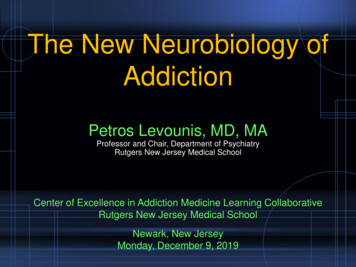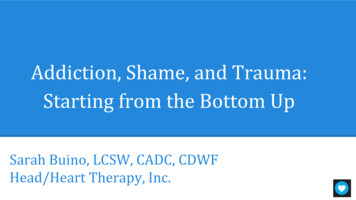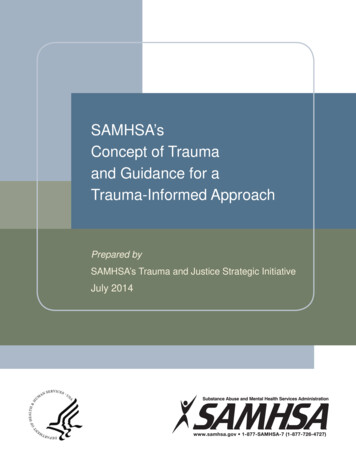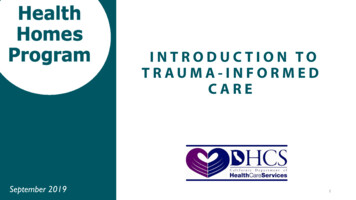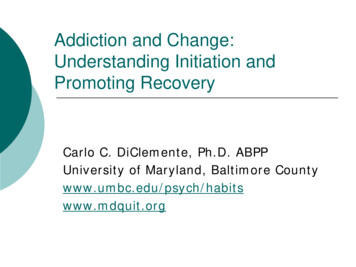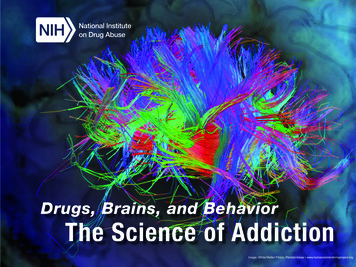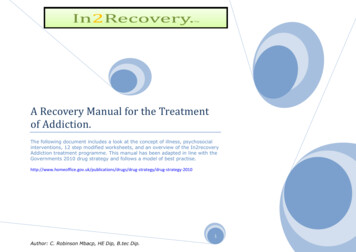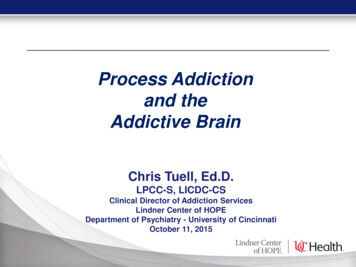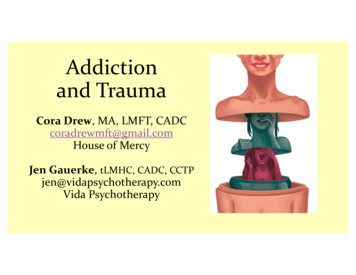
Transcription
Addictionand TraumaCora Drew, MA, LMFT, CADCcoradrewmft@gmail.comHouse of MercyJen Gauerke, tLMHC, CADC, CCTPjen@vidapsychotherapy.comVida Psychotherapy
Objectives:Participants will:1. Define addiction and trauma.2. Describe the brain’s role in trauma and addiction- “brain disease”3. Explain the trauma and addiction loop.4. Recognize crisis and need for referral as ethicalbest practice: continued use/OD, withdrawals,suicidality.5. Demonstrate treatment recommendations andinterventions, including mindfulness.
What is it? Addiction :Any dysfunctional and habitualform of coping with emotions,such as This leaves the root problemunaddressed, the emotional needunmet, creating a feedback loop.Organizing their life around theaddiction. (Abel & O’Brien) Trauma:When an event or situation in thepast overwhelmed a person’sability to cope, creating anemotional wound, leavingenduring physiological andpsychological distress andadaptation. This also can createa feedback loop.
Wile E Coyote: Middle aged male coyote, under nourished, no supportivefamily, little socialization.
“Being traumatizedmeans continuingto organize your lifeas if the traumawere still going on–unchanged andimmutable–as every newencounter or eventis contaminatedby the past.”(Van Der Kolk, 2014, 53)
Disease model of Addiction
Is it Use – casual, infrequentAbuse – toleranceDependence - physicalAddiction- life centeredSubstance Use Disorder –DSMV
Connecting Addiction & Trauma Executive Functioning (Decision Making – choice argument) Trauma hijacks the usual ‘top down processing’ (Levine, 2010). Automatic prioritizing of needs (McCauley, 2010, Pleasure Unwoven) Shame and blame Clinical issues with stages of change (Abel & O’Brien) TraumaPTSDUseRelief
Un-firing and Un-wiring; escaping the limbic system.
Starting Treatment:Do not rush into treating trauma!BEGIN:Build relationshipSafety (harmreduction/abstinence)Teach coping/resourcing skillsMedication managementTHEN:Utilize Methadologies
Wile is court-ordered to treatment Addressing Addiction Assessment (ASAM) Treatment approachAddressing Trauma Assessment (biopsychosocial) Therapeutic approach
Wile is court-ordered to treatment Addressing Addiction Assessment (ASAM) Treatment approach Relapse PreventionAddressing Trauma Assessment Therapeutic approach Processing trauma Increased symptoms &emotional distress
Relapse Prevention Plan forDate:Triggers (Internal and External)Relapse Prevention Planning1.5.2.6.3.7.4.8.Red Flags-Triggers (Internal and External)-Red Flags-Coping Skills/Resourcing*Positive Self Talk1.5.2.6.3.7.4.8.Coping Skills/ Resourcing1.5.2.6.3.7.4.8.Professional Support System1.4.2.5.3.6.Personal Support System-Professional Support System-Personal Support System-What do I need? (HALTS)1.4.2.5.3.6.What do I need? (HALTS)1.4.2.5.3.6.Keep a copy of this plan in a place where you can access it easily and use it when you are struggling with difficult emotions,thoughts, and decisions. If you are having thoughts of suicide or self-harm to immediately go to the nearest hospital, call thesuicide hotline 1-800-273-8255, or call 911.Client signatureClinician signature
Wile is court-ordered to treatment Addressing Addiction Assessment (ASAM) Treatment approach Relapse Prevention &Triggers* Relapse ProcessingAddressing Trauma Assessment Therapeutic approachRelapse Processing trauma Increased symptoms &emotional distress
Wile is court-ordered to treatment Addressing Addiction Assessment (ASAM) Treatment approach Relapse Prevention &Triggers* Relapse ProcessingAddressing Trauma Assessment Therapeutic approachRelapse Coping skills Create Recovery Lifestyle Eliminate addictive behavior Processing trauma Increased symptoms &emotional distress Coping skills Decreasing trauma symptoms Increasing daily function
Questions to ask for possible referral: Does the client report current daily substance use or issues withbasic functioning? Higher level of care may be required to interruptuse – review ASAM dimensions/criteria Is the client using opiates, benzos, or alcohol, which could lead tolife-threatening withdrawals? Medical intervention/inpatient Are the client’s PTSD-type symptoms and/or substance usepersisting despite your standard clinical interventions? Scope ofpractice, review DSMV Is the client suicidal or at risk for overdose (during and aftertreatment)? Harm reduction, safety planning
ADDICTIONRECOVERYGROUPFlyers available forgroups!For adults seeking supportin ongoing recovery fromchemical addiction.Jen Gauerke, tLMHC, CADC, is starting a new recoverygroup at Vida Psychotherapy in West Des Moines. Thisgroup will educate about the aspects of recovery, theimpact of trauma, and the shame of addiction. It willalso provide a setting to explore self and relationshipswith a caring group of adults who are striving for abetter life and continued recovery. This is not a 12 Stepgroup and is not a replacement for intensive inpatienttreatment or individual therapy.Time and dates will be determined as group membersmeet with Jen for intake interviews and according tothe availability of membership. Some insuranceproviders may cover the cost of services, or the out ofpocket fee is 100 for intake and 32 per group.STARTING SOON!GROUP WILL BE LIMITED TO 8PARTICIPANTSContactJen Gauerke(515)528-7892To schedulean intake sessionjen@vidapsychotherapy.com
Objectives:Participants will:1. Define addiction and trauma.2. Describe the brain’s role in trauma and addiction- “brain disease”3. Explain the trauma and addiction loop.4. Recognize crisis and need for referral as ethicalbest practice: continued use/OD, withdrawals,suicidality.5. Demonstrate treatment recommendations andinterventions, including mindfulness.
Addiction Treatment Approaches Motivational Interviewing (MI)CBTAcceptance and Commitment Therapy (ACT)EMDRMindfulness-Based Relapse PreventionMindfulness-based Stress Reduction (MBSR)Groups, including community based.(AA, NA, SMART, Celebrate, Refuge Recovery) Psychiatry – medication managementIncluding MAT (as needed for opiate and alcohol-related disorders) Psychoeducation and early intervention Case management Trauma Informed Care in Substance Abuse Counseling
Trauma Processing Approaches Narrative (Trauma Focused CBT)Eye Movement Desensitization Reprocessing (EMDR)Somatic ExperiencingCreative Stress Reduction (Yoga, art,etc.)Dialectical Behavioral TherapyAttachment/EFT for IndividualsEmotionally Focused Therapy (for couples triggering each other)Prolonged Exposure, Rewind Technique, Brainspotting (suggested byattendees)
ACT – Acceptance & CommitmentTherapy (by Russ Harris)Meet client where theyare with the Hexaflex(addiction may startwith acceptance) Be here nowKnow what mattersDo what it takesPure awarenessWatch your thinkingOpen Up
EMDR & Window of Tolerance
Polyvagal Theory Chart
Mindfulness and Meditation“Mindfulness is the process of ‘paying attention in a particular way:on purpose, in the present moment, and non-jugmentally.’”Benefits:Stuctural Brain ChangesReduced Autonomic ArousalPerceptual ShiftIncrease in SpiritualityGreater Situational awarenessValues ClarificationIncrease in Self AwarenessAddiction SubstitutionUrge SurfingLetting GoShonin, E. & Van Gordon, W. Int J Ment Health Addiction(2016). �Beauty of Silence” by Gloria Rothrock
What are we bringing to the relationship?Remember self care!Personal trauma of therapistNegative core beliefs about addiction and traumaCountertransference
References Understanding Addiction as a disease video. https://youtu.be/6GMwAsdCOI The Body Keeps the Score: Brain, Mind, and Body in the Healing ofTrauma (van der Kolk, 2015: Penguin Group) In An Unspoken Voice: How the Body Releases Trauma and RestoresGoodness (Levine, 2010) The Mechanisms of Mindfulness in the Treatment of Mental Illnessand Addiction (Shonin, E. & Van Gordon, W.) Int J Ment HealthAddiction(2016). 14.844. https://doi.org/10.1007/s11469-0169653-7 Treating Addictions with EMDR Therapy and the Stages of Change(Abel & O’Brien, 2015)
Suggested Readings Co-occurring Disorders: Integrated Assessment and Treatment of SubstanceUse and Mental disorders (Atkins, 2014) Integrated Dual Disorders Treatment Revised: Best Practices, Skills, andResources for Successful Client Care (Dartmouth, 2015) Seeking Safety: A Treatment Manual for PTSD and Substance Abuse (Najavits,2002) - IPV/DV specific The Body Keeps the Score: Brain, Mind, and Body in the Healing of Trauma(van der Kolk, 2015) In An Unspoken Voice: How the Body Releases Trauma and Restores Goodness(Levine, 2010) In the Realm of Hungry Ghosts: Close Encounters with Addiction (Mate, 2010) Trauma Stewardship: an everyday guide to caring for self while caring forothers (van Dernoot, 2007)
Suggested Readings, continued Treating Addictions with EMDR Therapy and the Stages of Change(Abel & O’Brien, 2015) Rewiring the Addicted Brain; an EMDR-based treatment model forovercoming addictive disorders (Parnell, 2018) ACT made simple (Harris, 2009) at:https://www.actmindfully.com.au/upimages/ACT Made Simple Introduction and first two chapters.pdf EMDRandbeyond.com & EMDRIA Disordered Eating- Women, Food, and God (Roth, 2010) Sex addiction - Naked in Public (Sprout, 2015)
1. Define addiction and trauma. 2. Describe the brain’s role in trauma and addiction -“brain disease” 3. Explainthe trauma and addiction loop. 4. Recognize crisis and need for referral as ethical best practice: continued use/OD, withdrawals, suicidality. 5. Demonstrate treatment recommendations a


